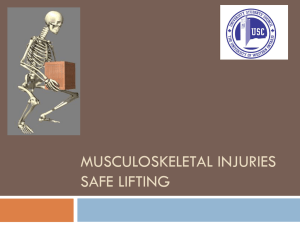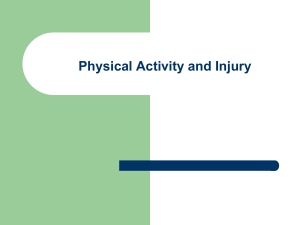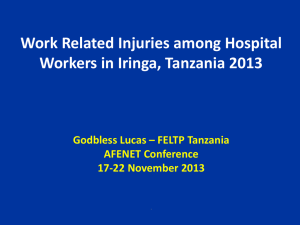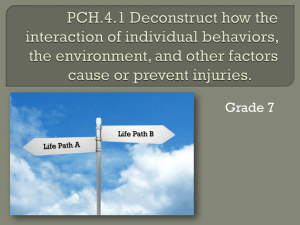NECA Safety Conference 2014 MPierce NECA Deck-1
advertisement
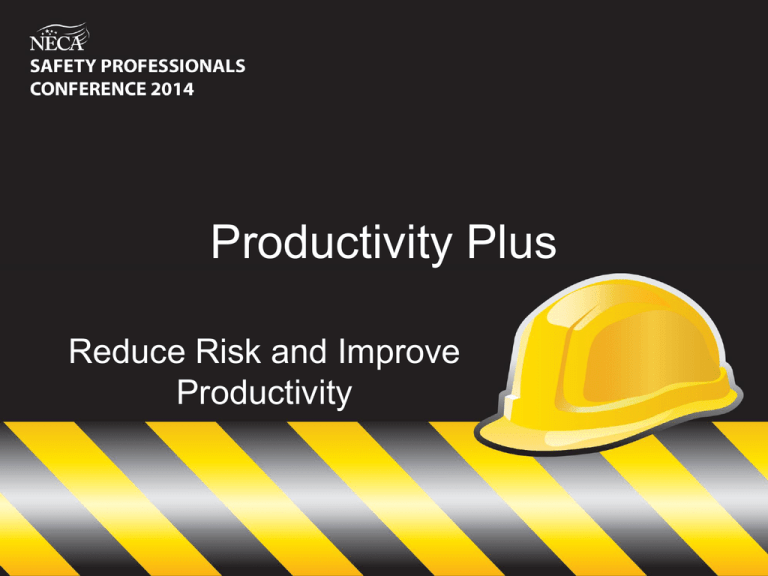
Productivity Plus Reduce Risk and Improve Productivity Continuing Education Credits NECA has been accredited as an Authorized Provider by the International Association for Continuing Education and Training (IACET) and is authorized to offer IACET CEUs for its programs that qualify under the ANSI/IACET Standard. This session is eligible for 0.1 IACET CEUs To earn these credits you must: • Have your badge scanned in and out at the door • Attend 90% of this presentation • Fill out the online evaluation for this session Learning Objectives – Add Value to What You Do 1. Explain the relationship between safety and productivity and why it is so important right now in our business. 2. Define what types of injuries are most common and/or most costly, in our business 3. Summarize conditions that, if changed, will reduce risk and improve productivity 4. Calculate the return on investment for a change that reduces risk and improves productivity and quality True Cost of Injuries and Waste? GR8 Electric Revenue WC Hard Cost 15,000,000 $60,000 (medical + Indemnity) Soft Cost $300,000 (5x Hard Cost) Impact of Injuries $360,000 Hours 208,000 Burden of Injuries per Hour $1.73 Typical Soft Costs Of Injuries • • • • • • • • Project delays Injury cleanup Wages of other workers Investigation costs Administrative costs Legal costs Productivity losses Loss of employee & customer goodwill • • • • • • • • • First Aid Costs Management time Supervisor time Replacement Costs Retraining costs Property damage Premium increases Lost job opportunities Dealing with OSHA & media True Cost of Injuries and Waste? GR8 Electric Revenue WC Hard Cost 15,000,000 $60,000 (medical + Indemnity) Soft Cost $300,000 (5x Hard Cost) Impact of Injuries $360,000 Hours 208,000 Burden of Injuries per Hour $1.73 True Cost of Injuries and Waste Waste Model GR8 Electric Auto Claims $6,000 General Liability Claims $1,000 OSHA / EPA Fines (Est.) $0 Soft Costs (5x) $35,000 Productivity Losses $433,000 20 Min. per day of treasure hunting, wasted motion, material handling, rework, etc. @ $50 rate Total Cost per Hour $475,000 $2.29 True Cost of Injuries and Waste Waste Model GR8 Electric Impact of Safety Costs per Hour $1.73 Impact of Other Losses per Hour $2.29 Total Estimated Cost per Hour $4.02 GR8 Electric Total WC, WL, GL and Productivity Cost Impact $835,000 New Business Required to Offset these Losses (at a 10% Margin) $8,350,000 History of Safety Performance US Workplace Deaths Injury Rates by Industry 6 20,000 18,000 5 16,000 14,000 4 12,000 3 10,000 8,000 2 6,000 4,000 1 2,000 0 1930 1935 1940 1945 1950 1955 1960 1965 1970 1975 1980 1985 1990 1995 2000 2005 2010 0 Annual Fatalities 2008 2009 2010 2011 2012 Utilities Petroleum Refineries EMCOR Electrical Contractors Mechanical Contractors Source: National Safety Council; Injury Facts 2011 Edition, and BLS Summary of Incidents in years noted. Why Has Safety Improved? • • • • • • Innovation Accountability Investment Measurement Management Commitment Increased Training • • • • • • • Competition Customers Cost Incentives Planning Employee Involvement Regulation History of Productivity Improvement Source: US Bureau of Labor Statistics, US Department of Commerce What Drives Productivity Improvement? • • • • • • Innovation Accountability Investment Measurement Management Commitment Increased Training • • • • • • Competition Customers Cost Incentives Planning Employee Involvement What is Value? What is your definition of Productivity? Productive Work vs. Waste Productive Work • • • • Direct Installation / Servicing Prefabrication (on or off site) Pre-Assembly Testing & Commissioning Wastes • • • • • • Defects and Rework Delivery and Material Handling Unnecessary Motion Inefficient Production Ineffective Activities Treasure Hunting A Relatively Young World in 2000 Under 5% 5% to 12.4% 12.5% to 20% Percent of Population Age 60+ in 2000 Source: U.S. Census Bureau Above 20% Rapidly Aging World by 2025 Under 5% 5% to 12.4% 12.5% to 20% Percent of Population Age 60+ in 2025 Source: U.S. Census Bureau Above 20% Rapidly Aging World by 2025 Workforce Demographics Percent Growth in the US Workforce by Age, 2010-2020 75% 73% 60% Today the majority of the US workforce is over 40 45% 54% 30% 15% 7% 8% 7% 0% 3% -10% -15% under 14 15-24 25-34 35-44 45-55 55-64 [i] US Census Bureau, National Population Projections Released 2008 (Based on 2000 Census): 65+ As We Age • Maximal Strength • Obesity • Muscle Mass • Arthritis • Bone density • High BP • Visual and Auditory Acuity • Diabetes • Fitness • Depression • Aerobic Capacity • Heart Disease • Cognitive Speed/Function • Wisdom & Experience Aging Workforce Average Days Lost By Age Per Injury* 50 40 30 48.9 The longer your employee is out of work the 47.7 more unlikely they will ever return to work 12 weeks, only 50% will return 26 weeks, only 25% will return 37.8 31.3 18.1 20 10.4 10 1.67 0 0 to 18 19 to 29 30 to 39 *Nationwide Data – All Industries, 2007 40 to 49 50 to 59 60 to 64 65+ Current Worker Population • Five people leave the construction industry for every one person entering • Only 33% of employers report that their organization have made projections about retirement rates of their workers • The National Electrical Benefit Fund (NEBF) Shows: – In 1947 there were 47 workers for every retiree – In 2001 there were 2 workers for every retiree – In 2003 there was 1 worker for every retiree Objective 1: Why Safety = Productivity • Injuries and waste both increase labor cost, reducing our competitiveness • The principles that we have successfully used to reduce injuries also improve productivity and quality • Workforce demographics demand improved safety performance as the workforce grows older and younger workers grow more scarce. Avg. Cost: $23,400 Claims and Costs Average Cost per Claim 2009-2012: $20,000 Four Year Claim Cost Avg. Cost: $30,200 Avg. Cost: $6,200 Overexertion Slip, Trip, Fall Struck By Avg. Cost: $192,500 Avg. Cost: $9,000 Fall From Elevation Caught In Avg. Cost: $21,000 Avg. Cost: $6,100 Vehicle Accident Other Source: EMCOR Group, Inc. Claim cost summary 2009-2012, CNA verified 02/21/14 (Adjusted to exclude extreme outliers from 2012) Root Cause of Injury? – Management and Safety Culture Contributory Causes of Injury & Their Contributory Cause Factors Tools & Equipment PPE Work Methods Not Trained in Use Not Trained in Use Bad Practice Unsuitable Not Adequate Accepted Practice Unavailable Not Issued Lack of Standards Not Used What you put in is Defective what you get out Not Provided Hazards Not Identified Physical Limitations JSA Not Undertaken Hazards Not Mitigated Distracted Worker Not Specific Enough Not Trained to Deal Age / Experience with Hazards Working Outside Capabilities Instruction Environment Human Factors Injury or Improved Productivity Causes of EMCOR Recordable Injuries ’09-’12 Tools & Equipment 7% PPE 9% Human Factors 15% Work Environment Not Identifying or Mitigating Hazards 28% Instruction 2% Work Methods 39% Poor Work Practice Work Methods 39% Not Dealing with Hazards 28% PPE 9% Tools & Equip. 7% Instruction 2% Total 85% Relationship Between Injuries & Other Claims Hundreds Of Recordable Injuries 1 Serious Event 1 Serious Event Hundreds Of Damage Claims Hundreds Of Auto Claims Tens of Thousands of Near Hits Tens of Thousands of Near Hits Tens of Thousands of Near Hits 1 Fatality Millions of Instances of POOR WORK PRACTICE Objective 2: The Most Common and Costly Injuries • Overexertion Injuries – those related to wear and tear on the body • Slip, Trip, Falls – Correlated to some of the physiological effects of aging • Falls from Elevation – Also correlated to age • Cuts – Unique to electricians Changing the Way We Work Making a change begins with OBSERVATION of the worker and the process The CHALLENGE to you – Observe, Measure, Change, Improve Changing the Way We Work What 2 Questions Do YOU Need to Ask? -- Why Are We Doing It That Way? -- Is There A Better Way To Do It? Working at Floor Level Best Practices – Staging Not So Good Example Best Practices - Staging Good Examples Vehicle Inventory - Housekeeping • “I cut my hand while reaching for PPE in the back of my truck” – Actual Incident Report NECA 2014 Products for Working Smarter Change Human Factors to Reduce Fatigue and Waste • The art of observing human beings as they are: – – – – – – Walking Bending Carrying Pushing Pulling Lifting – – – – – – Climbing Descending Twisting Reaching Improvising Etc., etc., etc. … and questioning why work is being done that way Change Human Factors to Reduce Fatigue and Waste • The art of observing human beings as they are: – – – – – – Walking Bending Carrying Pushing Pulling Lifting – – – – – – Climbing Descending Twisting Reaching Improvising Etc., etc., etc. … and questioning why work is being done that way Change Human Factors to Reduce Fatigue and Waste • The art of observing human beings as they are: – – – – – – Walking Bending Carrying Pushing Pulling Lifting – – – – – – Climbing Descending Twisting Reaching Improvising Etc., etc., etc. … and questioning why work is being done that way Change Human Factors to Reduce Fatigue and Waste • The art of observing human beings as they are: – – – – – – Walking Bending Carrying Pushing Pulling Lifting – – – – – – Climbing Descending Twisting Reaching Improvising Etc., etc., etc. … and questioning why work is being done that way Change Human Factors to Reduce Fatigue and Waste • The art of observing human beings as they are: – – – – – – Walking Bending Carrying Pushing Pulling Lifting – – – – – – Climbing Descending Twisting Reaching Improvising Etc., etc., etc. … and questioning why work is being done that way Change Human Factors to Reduce Fatigue and Waste • The art of observing human beings as they are: – – – – – – Walking Bending Carrying Pushing Pulling Lifting – – – – – – Climbing Descending Twisting Reaching Improvising Etc., etc., etc. … and questioning why work is being done that way Change Human Factors to Reduce Fatigue and Waste • The art of observing human beings as they are: – – – – – – Walking Bending Carrying Pushing Pulling Lifting – – – – – – Climbing Descending Twisting Reaching Improvising Etc., etc., etc. … and questioning why work is being done that way Changing the Way We Work Body Mechanics Study: • Average Age: 38 • Tested: – – – – – Strength Hand strength Pinch grip Range of motion Aerobic capacity Most Common Failure Only 42% Passed! Working Smarter • P Personal • Productivity P • E Equipment Working Smarter • Personal • Productivity P • Equipment E Working Smarter • Personal • Productivity P • Equipment E Objective 3: How to Reduce Risk & Improve Productivity • Reduce the need to walk, bend, climb, descend, reach, carry, push, pull, etc. • Use innovative tools to reduce fatigue • Human factors issues are just as important (sometimes more important) as any safety rule – treat them that way! Quantifying the Value of a Change “If you need a machine and don’t buy it, then you will ultimately find that you have paid for it and don’t have it.” – Henry Ford The Value of a Change • What are the current costs? – Labor Cost – Tools Cost – Value of Risk • What is the value of alternatives? – What is the cost of the necessary investment and is it offset by improved productivity or reduced risk of injury Annualize Calculations Cost Factor Current State Proposed State Labor (Material Handling Time) 30 Min. Day x 10 workers at $60 hr. = $300 / day or $75,000 / year 10 Min. Day x 10 workers at $60 hr. = $100 / day or $25,000 / year Risk: Slip Trip and Fall, Overexertion, Fatigue from working overhead 1/4th of average injury cost per year: $20,000/4 =$5,000 (one average injury every four years) 1/10th of average injury cost per year: $20,000/10 =$2,000 (one average injury every 10 years.) $80,000 $27,000 NA $53,000 Tool Investment (Carts) No Cost 5 x $800 = $4,000 Payback Time for investment NA Investment of $4,000/Daily Savings of 20 min. per day x 10 people: $200 = 20 days Total Annual Cost Savings Objective 4: Measuring the Value When Nothing Happens • Know (calculate, estimate, measure, etc.) the value of the current process, including the value of the risk of injury • Identify alternative processes (tools, work methods, etc.) • Calculate the value of the change (the return on safety/productivity investment) • When change in quantified, management is more likely to support change. Applying the Learning Objectives 1. Explain to your company the relationship between safety and productivity and why it is so important right now in our business. 2. Now that you know what types of injuries are most common and/or most costly, act to prevent them. 3. Observe and change the work to reduce risk and improve productivity 4. Calculate the return on investment for a specific change in your company that will reduce your risk and improve your productivity and quality NECA 2014


